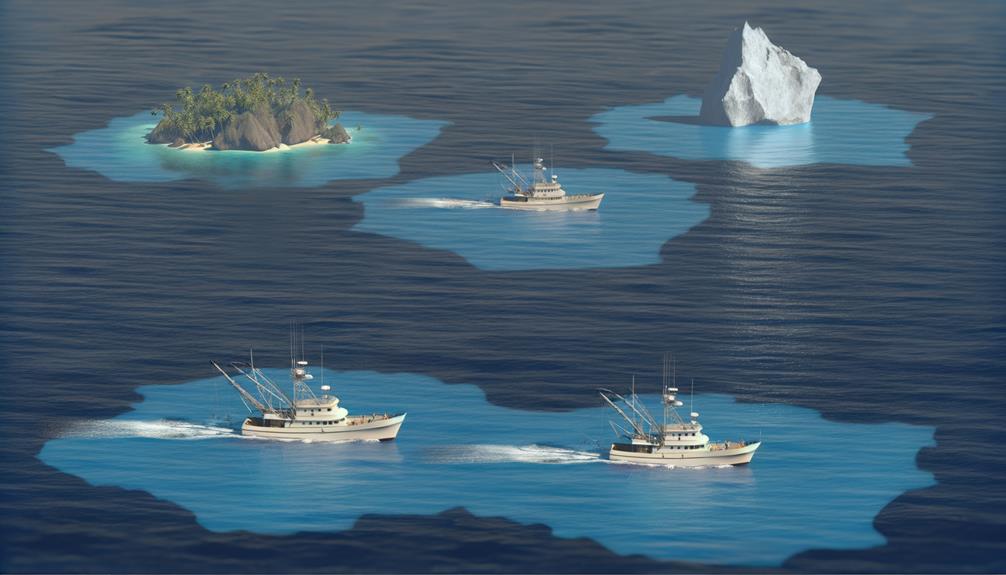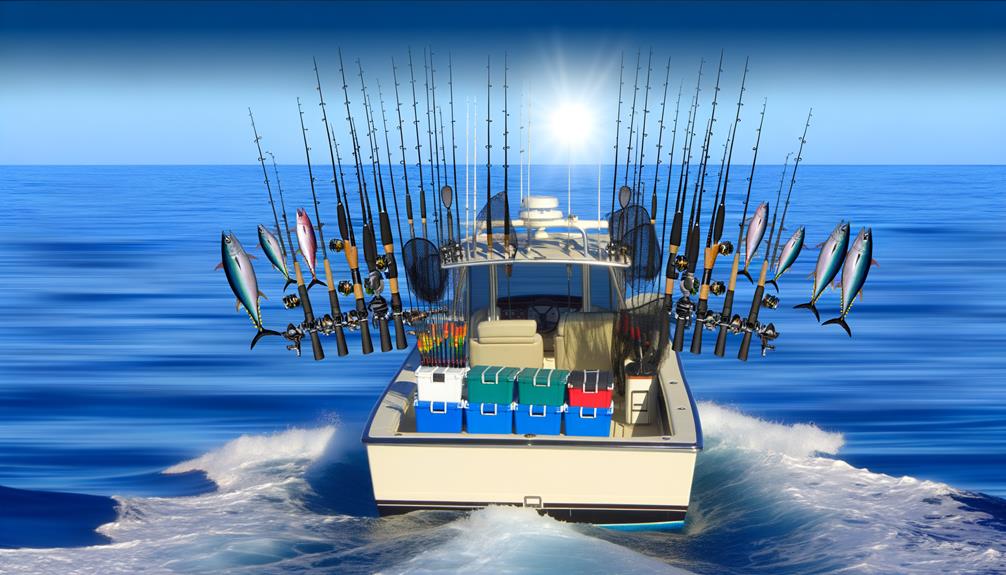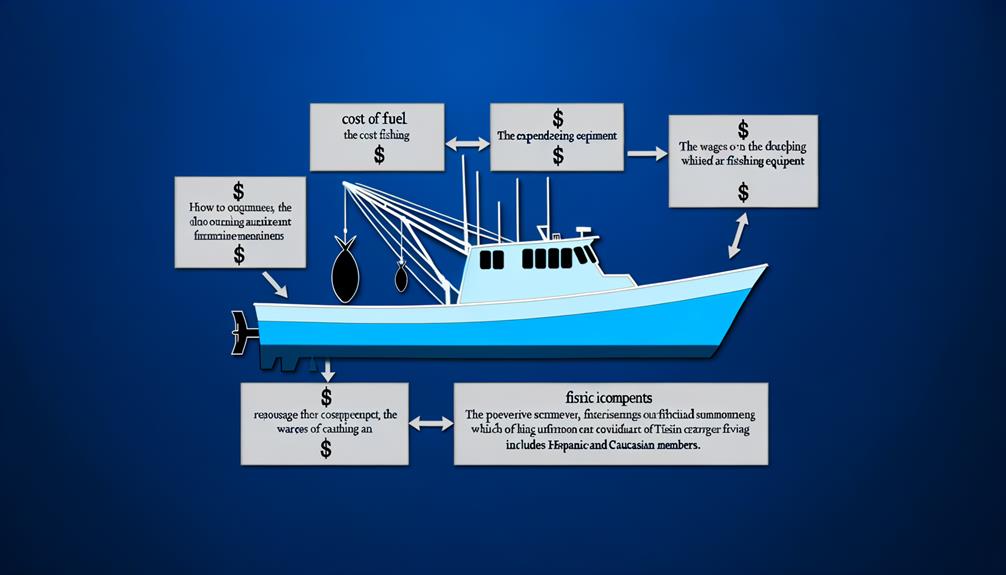'You know what they say, there's plenty of fish in the sea, but there's nothing quite like the thrill of hooking a blue fin tuna.
You've probably heard about the unique adventure that is a blue fin tuna fishing charter, but what does it really entail?
Let's pull back the curtain on these deep-sea fishing trips where you're not just a passenger, but an active participant.
From the moment you step aboard to the adrenaline rush of reeling in a big catch, we'll take you through everything you need to know.
Interested? Let's get started.'
Key Takeaways
- Responsible fishing practices are crucial to protect the bluefin tuna population and ensure sustainability.
- When choosing a charter, consider factors such as the trip duration, amenities, recommended jigs, departure times, and compliance with regulations.
- Prime locations for tuna fishing include offshore waters with deep sea reefs and oil platforms over 120 miles offshore.
- The best time for tuna fishing is early morning, and the summer months are particularly good for yellowfin tuna fishing in Texas.
Understanding Blue Fin Tuna
Diving into the deep waters of offshore reefs and structures, you'll find the bluefin tuna, a species often targeted during extensive 36-hour trips at depths ranging from 150 to 400 feet. This is no ordinary fishing trip. It's an immersive, thrilling adventure, where you're pitted against the giant bluefin tuna, one of nature's most formidable marine creatures.
You'll need to be well-equipped for this endeavor. Recommended tackle includes butterfly jigs, diamond jigs, and tuna poppers, with at least four jigs sized six or eight oz. These tools are specifically designed for the task at hand, and using them correctly can make the difference between a successful catch and walking away empty-handed.
But it's not just about the thrill of the chase. It's also about responsible fishing. Regulations exist for a reason. They include catch limits, size restrictions, and the need for fishing licenses. These rules are in place to ensure sustainable fishing practices and to combat the decline of the bluefin tuna population due to overfishing and illegal practices.
In this journey, you're not just an angler. You're a steward of the sea.
Choosing the Right Charter
When you're setting out to choose the right charter for your bluefin tuna fishing adventure, several key factors should guide your decision-making process.
Selecting from the range of Tuna Charters available might seem daunting, but if you focus on some essential criteria, you'll find the best fit for an unforgettable offshore experience.
Consider these key factors:
- Duration of the Trip: Opt for a 36-hour trip if you're after the full offshore experience, targeting deepwater species.
- Vessel's Amenities: Look at the comfort level of the boat. Check for spacious cabins, sleeping bunks, and dining options.
- Recommended Tackle and Gear: Find out what jigs are recommended for tuna fishing. Also, ask if you need to bring personal fishing gear or if it's provided.
- Departure and Eligibility Criteria: Check departure times and eligibility for free offshore charters. Also, make sure to familiarize yourself with the latest NMFS Bluefin Tuna regulations.
Lastly, don't forget to consider rates, departure times, and the booking process. Ensuring you're comfortable with these factors will make your bluefin tuna fishing adventure a memorable experience.
Prime Locations for Blue Fin

After you've chosen your ideal charter, it's crucial to consider the prime locations for bluefin tuna fishing, which can significantly enhance your offshore experience. These prime spots tend to be offshore waters with deep sea reefs and structures ranging from 150-400 feet deep. Here, you'll find bountiful schools of bluefin tuna, particularly in the early morning hours, as charters typically leave the dock promptly at 4:00 AM.
Consider night fishing at floating oil platforms over 120 miles offshore. This presents a unique opportunity to target not just bluefin, but also yellow and blackfin tuna.
Locations like Freeport, Galveston, and South Padre Island in Texas are ideal spots for yellowfin tuna fishing, particularly in the summer months.
To better guide your choice, here's a table showcasing these prime locations, their unique features, and the best time for tuna fishing:
| Location | Unique Features | Best time for Tuna Fishing |
|---|---|---|
| Offshore Waters | Deep Sea Reefs, 150-400ft deep | Early morning |
| Oil Platforms | Over 120 miles offshore | Night time |
| Texas (Freeport, Galveston, South Padre Island) | Popular yellowfin locations | Summer |
Remember to book your charter in advance to secure the best experience in these prime spots.
Seasonal Tuna Fishing Tips
In gearing up for your blue fin tuna fishing adventure, it's crucial to understand the seasonal nuances that can impact your success. Keep in mind the importance of choosing the right bait and timing your fishing excursions optimally.
Let's explore some key tips that can bolster your chances of landing a big catch, starting with bait selection and the best times to fish.
Effective Bait Selection
Choosing the right bait is a game-changer in blue fin tuna fishing, and it's essential to vary your selection according to the season and location. The act of bait selection is an art itself, and you need to adapt to the specific habits and dietary preferences of the tuna during each season.
You'll find the following bait selections effective:
- In spring and summer, live bait such as mackerel, sardines, and squid are alluring to tuna.
- During fall and winter, artificial lures like poppers, jigs, and soft plastics are favored.
Understanding the natural prey of tuna during different seasons aids in bait selection.
Adapting bait selection to the seasonal habits of the tuna significantly increases your chances of a rewarding catch.
Ideal Tuna Fishing Times
For optimal blue fin tuna fishing, you'll want to target the summer months, particularly from June 16 to October 31, keeping in mind that filming dates are exceptions.
It's best to book your tuna trips 69 days in advance, considering weather conditions and migration patterns that influence the availability of these prized catches.
Remember, blue fin tuna charters leave the dock promptly at 4:00 AM, so punctuality is key.
If you're lucky enough to reel in a giant blue fin tuna over 73 inches, you may be eligible for a free offshore charter.
Don't forget, fishing licenses are required, and bag limits and fishing season regulations are in place to ensure sustainable fishing practices.
Equipment Essentials for Tuna Fishing

When preparing for a Blue Fin Tuna fishing adventure, your choice of equipment is critical. Your fishing rod selection, bait, and tackle essentials can make a significant difference in your success rate.
Furthermore, understanding the importance of navigational tools, even though you can't bring your own GPS device, will also enhance your fishing experience.
Selecting Your Fishing Rod
A suitable fishing rod, one with heavy-duty construction, is a must-have for successfully reeling in large tuna. It's crucial to consider several key features when selecting your rod.
- Look for a fast-action rod with a heavy power rating. This combination is ideal for battling the strength of a large tuna.
- Consider a rod length between 6 to 7.5 feet. This provides the necessary leverage to control your catch.
- Opt for high-quality guides and a robust reel seat. These withstand the intense pressure of tuna fishing.
- Choose a rod type that suits your fishing technique and environment. Stand-up rods, for example, are perfect for on-boat fishing.
Bait and Tackle Essentials
Having chosen a suitable rod, you'll now want to focus on gathering the right bait and tackle essentials for a successful tuna fishing trip. Equip yourself with butterfly and diamond jigs, preferably chrome. Bring at least four jigs, sized six or eight oz, for efficient fishing.
Tuna poppers are also a must-have. Though optional, consider bringing your personal fishing rod and gear for familiar equipment's comfort. Don't forget the camera to capture your memorable fishing experience. Carry enough cash for snack bar treats and gratuities.
As you prepare for your fishing trip, remember, it's not just about the catch, but the journey as well. Equip yourself well, belong to the sea, and let the adventure of tuna fishing begin.
Navigational Tools Importance
To maximize your success on a tuna fishing expedition, it's critical to master the use of essential navigational tools such as GPS devices, nautical charts, and depth finders. These tools hold paramount importance when embarking on deep sea fishing charters.
Here's why:
- GPS devices ensure precise navigation and accurate positioning in the vast ocean.
- Nautical charts help to avoid hazards and locate prime fishing spots.
- Depth finders, when combined with your skill and experience, can lead you to the perfect depth for tuna.
- Radar and sonar systems aid in detecting schools of tuna, increasing your chances of a successful catch.
Charter Costs and Considerations

When considering a bluefin tuna fishing charter, you'll find costs ranging from $2000 for a 12-hour trip to $4120 for a full day, with additional expenses such as a 15-20% mate's tip, fishing licenses, and gratuities. These fishing charters often depart at 4:00 AM and prices don't include the mate's tip. However, there's a chance to win a free offshore charter if you catch a giant bluefin tuna over 73 inches.
Here's a quick breakdown of the costs and considerations:
| Cost/Consideration | Details |
|---|---|
| Charter Cost | $2000-$4120 |
| Mate's Tip | 15-20% |
| Additional Expenses | Licenses, gratuities |
| Departure Time | 4:00 AM |
Remember to bring a sleeping bag, rubber deck boots, a change of clothes, and ziplock bags for fish cleaning. Note that GPS devices, personal pronouns, email, and Twitter are not allowed on board. Fishing licenses are mandatory for yellowfin tuna fishing in Texas, and bag limits and fishing season regulations are implemented to ensure sustainable practices. Fat Tuna Charters in Gloucester, MA offers a fantastic fishing experience with local knowledge, the latest fishing gear, and comfortable vessels for various applications.
Successful Tuna Fishing Stories
Diving into successful tuna fishing stories, you'll find tales of intense 36-hour deep sea excursions, where anglers target species such as snapper, grouper, amberjack, and of course, the prized tuna in deepwater reefs and structures. Exciting adventures often begin miles offshore on the Capt. John Catamaran, a 75-foot vessel that provides a comfortable base for your journey.
To make your story a success, consider these key elements:
- Bring specific tackle such as butterfly jigs and tuna poppers, these greatly enhance your chances of nabbing a big one.
- Don't forget your personal fishing gear and a camera to capture the thrill of the chase and the triumph of the catch.
- Engage with the Bluefin tuna charters. It's not just about the catch, but also the eligibility for free offshore charters and future charter money based on the fish sale.
- Consider booking with Fat Tuna Charters in Gloucester, MA. With over 40 years of local fishing expertise, they offer a finely-tuned bluefin tuna fishing experience.
Frequently Asked Questions
How Much Does It Cost to Catch Bluefin Tuna?
You're looking at roughly $2000 to catch bluefin tuna, with additional costs for tuna licensing. It's a worthwhile investment, offering camaraderie and potential profits from a successful catch. Prices can fluctuate, so plan accordingly.
Do the Wicked Tuna Boats Do Charters?
Yes, some boats from the show "Wicked Tuna" do offer charter experiences. You'll be able to enjoy a thrilling adventure, learning from experienced crews, while feeling a sense of belonging among fellow fishing enthusiasts.
Where Is the Best Bluefin Tuna Fishing?
You'll find the best bluefin tuna fishing in deep waters on 36-hour trips. Be mindful of tuna conservation, using recommended tackle like butterfly jigs. Remember, it's not just about the catch, but the experience.
How Much Does It Cost to Go Tuna Fishing in Florida?
"You're looking at around $2000 for a 12-hour tuna fishing trip in Florida. Remember, this doesn't include the 15-20% mate's tip. Plan accordingly to ensure a smooth, enjoyable fishing experience."
Conclusion
So, you're ready to tackle the thrill of deep-sea fishing with Blue Fin Tuna Fishing Charters. You've got the knowledge, the tips, and the gear. All that's left is the adventure itself.
Remember, every successful fishing story starts with a leap of faith. So, why not take yours? Dive into the depths, feel the salt spray, and reel in the catch of a lifetime.
After all, isn't that what fishing dreams are made of?
